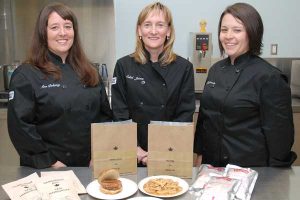Rations testing, a tasty improvement
By Lookout on Sep 03, 2013 with Comments 1

Meal rations are being reviewed in the field by Ann Delaney (left), Edith Jutras (centre) and Julie Brooks (right).
This fall, soldiers on exercises at various field units will be eating their lunch with the team from the PMO National Combat Rations Programme who will be hearing comments and opinions on the food and its packaging in an operational environment.
Edith Jutras, Manager of the Program, says ration packs used to have feedback forms inside, but the rate of return was extremely low.
She believes being in the field with the troops will build an understanding of what soldiers like and don’t like about their rations, and will help steer improvements in years to come.
“The troops will have a chance to meet and talk directly with us,” she says. “In the past few years we have focussed our efforts on improving food taste and variety. Now we will evaluate the packaging in order to make it more in line with soldiers’ needs. We’ve already cut down the number of loose items in the ration pack in response to soldier comments, and we’re looking at switching to reusable packaging if possible.”
The PMO National Combat Rations Programme is part of the Directorate of Food Services in the DCOS division and is responsible for the shelf-stable packaged meals that are provided to soldiers in the field.
The small three-person team designs the rations and validates requirements, works with industry to develop recipes and new products, contracts for all the components, supervises production and assembly, conducts testing and quality validation, and provides expertise on stock management.
Combat rations must adhere to NATO standards for nutrition and interoperability so allied soldiers can easily eat rations during joint operations.
The team works years ahead due to a long production and procurement process; currently they are developing menus for 2015.
Around one million Individual Meal Packs or IMPs are produced every year and close to 100,000 Light Meal Combat packs or LMCs every two years. Approximately 20,000 survival rations are also produced every five years. Each component is manufactured separately, then shipped to an assembler in Montreal who packages all the food and non-food items together to form the various ration packs. Other rations such as the Vegetarian/Halal/Kosher and survival rations for life rafts are purchased ready-made on a yearly basis.
The IMP main course is packaged in a retort pouch made from layers of flexible laminate. All food items need to have a shelf life of three years and be consumable straight from the pouch without adding water or heating.
The challenge says Ann Delaney, a Technical Assistant with the Programme, is to ensure that everything in the ration pack be eaten so that soldiers are getting optimal nutrition. She explains that packaged peaches are an example of a food that looks and tastes fine in a test situation, but doesn’t work out so well in practice.
“The peaches are slippery and impractical to eat under field conditions. So we are currently looking for alternatives to this fruit.”
Beef jerky, on the other hand, is ideally suited to the field. Included in a ration pack it can be slipped in a pocket and consumed whenever and wherever.
Delaney says the jerky is one of many additions and improvements that have been made to the IMP in recent years. A good protein bar and hot sauce have also been crowd pleasers. Chocolate bars are now included with both lunch and dinner IMPs, and a new sliced bread product has been a welcomed addition.
“One of the refinements we’re looking at is trail mix with nuts. Nuts are very good nutritionally but our challenge has been shelf life. We’re looking at coated nuts as an option or a mix that is packaged with nitrogen instead of air,” says Delaney.
In 2014 soldiers can look forward to an IMP hamburger and a vastly improved coffee that is espresso-based and much richer in flavour, says Julie Brooks, also a Technical Assistant with the Programme.
“Food is very important for morale. Soldiers want food that is familiar. We introduced poutine in the IMP that, although made with cooked, rather than fried potatoes, has chicken and cheese curds and a rich gravy. During the trials, soldiers loved it and are now even blogging about it,” she says.
All three team members have degrees in food science, but agree that food is about more than science.
“Of course we need to ensure that our soldiers are getting the nutrition they need,” says Jutras. “But it is also vitally important to us that the food is tasty, easy to eat and we include items soldiers want in their rations. We’re really looking forward to sitting down with soldiers in the field and finding out what they think.”
-Materiel Group International Communications
Filed Under: Top Stories
About the Author:






I must say it was hard to find your blog in search results.
You write awesome content but you should rank your website
higher in search engines. If you don’t know how to do it search on youtube: how to rank a website Marcel’s way